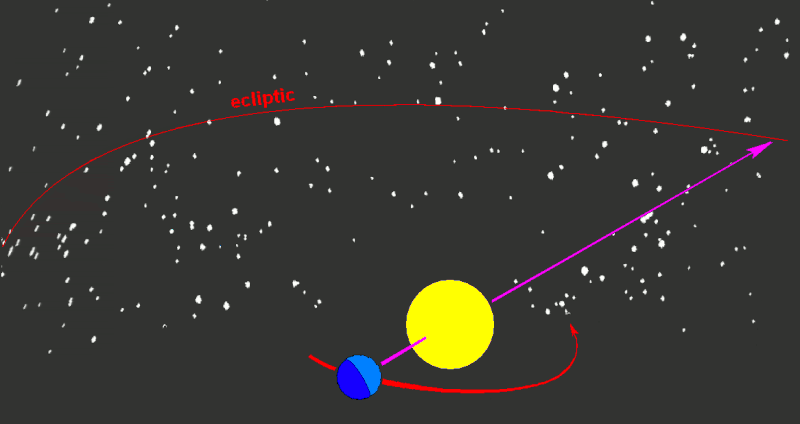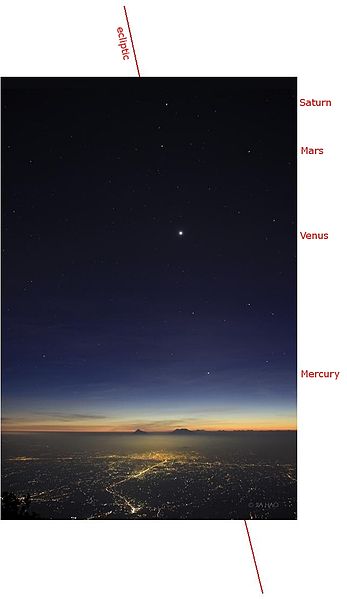
The ecliptic is an imaginary line on the sky that marks the path of the sun. The moon and planets also travel along the path of the ecliptic. It’s the projection of Earth’s orbit onto the celestial sphere, and it marks the plane of the solar system. Tracing the paths of the planets in front of the background stars, you’ll see that the ecliptic passes through the constellations of the zodiac.
The ancients were able to predict when eclipses would occur by paying attention to the movement of bodies along the ecliptic. This invisible line across the sky is the starting point for the celestial coordinate system used by astronomers to pinpoint the location of every star, nebula and galaxy.

How to visualize the ecliptic
To better understand this region of the sky, let’s start with a ride on a carousel.
Sitting on a wooden horse, your hands clasped around a cool, brass pole, you swing around and around. The sights of an amusement park blur past your vision. As you circle around, your eyes wander and become fixated on the central pillar of the carousel. The pillar goes out of focus, and you notice what’s on the other side. The ticket booth goes by, then a food vendor. There’s a family posing for a picture, then some benches with people resting their feet. Eventually, you come all the way around and are looking at the ticket booth again.
Now replace the horse with Earth, the column with the sun, and the background panorama of an amusement park with the distant stars. As Earth flies around the sun at 67,000 miles per hour (108,000 km/h), the “scenery” behind the sun changes.
For example, if we could see the stars during the day, we would notice that in late March and early April, the constellation Pisces the Fish is on the other side of the sun. As the days and weeks went by, the sun would appear to drift eastward across Pisces until moving in front of Aries the Ram in the second half of April. One month later, the sun would be flanked by the stars in Taurus, then Gemini, Cancer, Leo and so on. Roughly every month or so, as Earth moves in orbit, a different constellation sits behind the sun.
The ecliptic and the zodiac
If those constellation names sound familiar, it might be because you’ve seen them in your newspaper’s horoscope section. The signs of the zodiac come from the constellations through which the sun passes. They are the constellations which lie in Earth’s orbital plane.

Though Western astrologers have only ever recognized 12 signs, there are actually 13 constellations that lie along the path of the zodiac. The 13th, which didn’t make the astrologer’s cut, is the constellation Ophiuchus. It’s the constellation of the Serpent-Bearer, partially located along the ecliptic between the summer constellations of Scorpius and Sagittarius.

The key to eclipses
The ecliptic – the line across our sky defined by the sun’s path – gets its name from the fact that eclipses can only occur along it. A lunar eclipse happens when the moon passes through Earth’s shadow, when it is directly opposite the sun on the sky. During a solar eclipse, the moon passes between Earth and the sun, momentarily blocking out its light and warmth.
Though the moon circles Earth roughly once a month, eclipses don’t happen nearly that frequently because the moon’s orbit tilts slightly relative to that of our planet. Our satellite actually spends most of its time either above or below the plane of Earth’s orbit and, therefore, is usually not nicely aligned with us and the sun. Twice a month it crosses the ecliptic, but an eclipse will only occur when that passage happens during either a full moon for a lunar eclipse or a new moon for a solar one. The need for this precise alignment is why eclipses happen only a couple of times a year at most.

The path of the planets
Since the other seven planets orbit in approximately the same plane as Earth, the ecliptic is also a decent guide to where you’ll see the planets in the sky. To put that another way, the planets allow you to actually trace out the ecliptic on any clear night yourself. Right now (February 2022), Mars, Venus and Mercury lead the sun up from the horizon in the morning. When the planets are visible, either morning or night, you can connect the dots to trace the path of the ecliptic. Then notice the constellations that these planets pass in front of, and you’ll be able to pinpoint the zodiac.
Bottom line: The ecliptic traces out the apparent annual motion of the sun across the sky. The planets and moon also lie close to the ecliptic in the plane of our solar system. They pass in front of the constellations of the zodiac.











